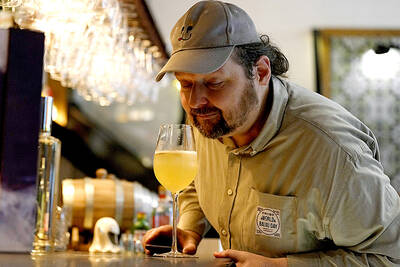As is usual for parties organized by Back 2 the Future (B2TF, 回到未來), Underworld (地下社會) was packed on Halloween night for a three-DJ set that started at 11:30pm with Yggiwt, and continued with Pomby (狄波拉) and then Floaty Keith until 4am, although the bar didn’t close until well after the sun had risen.
At least half of the crowd was wearing costumes, which included the usual vampires, zombies, a Bruce Lee and a man wearing a Stars Wars Storm Trooper helmet. But the trendiest theme of the evening for both men and women seemed to be dressing up like a member of 1970s glam-metal band Kiss, which meant donning a black cocktail dress and a nappy black wig and painting one’s face white with animal features or a black star drawn around one eye.
There was barely enough room to dance in the small basement club because more than 120 tickets were sold for the party, according to Wang Yuan-kang (王元康), of B2TF, also known as Chiu Sheng (秋生) of heavy metal band Triple Six (666). But dance people did, and all three DJs kept the groove going with a random mix of tunes ranging from “Weird Al” Yankovic’s Eat It to Common People by Pulp to Peaches’ Fuck the Pain Away.
National Taiwan College of Performing Arts (國立臺灣戲曲學院) has had a number of not inconsiderable successes in producing experimental works of Chinese opera. Unfortunately, The Plum Blossom Fan (桃花扇) at the National Theater over the weekend was not one of them. Having boldly leapt into the bloody melee of producing an opera that combines modern Western classical music and traditional Chinese opera, this attempt to bring about the dawn of a “modern Chinese musical” — the show’s aim as stated by scriptwriter Tseng Yung-yi (曾永義) — mostly produced bemusement among the first-night audience on Friday at the National Theater.
The show opened with an encouragingly empty stage — clearly the performers rather than the set designers were going to be the stars. Then the overture begin, and the performance seemed to lose its way almost from the get-go. It remained lost for most of the following two-and-a-half hours, unsure what it was supposed to be doing. The general feeling was of some slightly comic scenario in which a Chinese opera troupe has blundered into an orchestral rehearsal, and the two groups then proceeded to trip each other up.
The Taipei Philharmonic Orchestra (台北愛樂管弦樂團) under the energetic direction of conductor Liao Hsiao-ling (廖曉玲), had a score that according to the program notes, was intended to enhance the emotions of the opera. What it managed to do was trip up the performers, denying them the natural rhythms of Chinese opera so that their movements and singing drifted in a free-form cacophony that try as one might, was difficult to enjoy. Taipei’s generally enthusiastic audiences tried to find something to applaud, but the first occasion came almost 70 minutes into the show, and was directed at a battle sequence that featured none of the main stars, and owed its effect more to the choreographer and lighting technicians than to the composer or lyricist.
There was little to like in Yu Chang-fa’s (游昌發) score, and his unfortunate passion for brass, and growly bass notes from tubas, horns and cellos, seemed calculated to maximize the incongruity with what was happening on stage.
The performers, from the leads to the extras serving as soldiers and servants, were all clearly working hard and seemed generally well rehearsed, but neither lyrics, score or the ill-conceived format seemed to give them any breaks. National Taiwan College of Performing Arts’ Plum Blossom Fan joins the ranks of the many recent casualties that are the result of the current anxious search for a new format for traditional opera.

Behind a car repair business on a nondescript Thai street are the cherished pets of a rising TikTok animal influencer: two lions and a 200-kilogram lion-tiger hybrid called “Big George.” Lion ownership is legal in Thailand, and Tharnuwarht Plengkemratch is an enthusiastic advocate, posting updates on his feline companions to nearly three million followers. “They’re playful and affectionate, just like dogs or cats,” he said from inside their cage complex at his home in the northern city of Chiang Mai. Thailand’s captive lion population has exploded in recent years, with nearly 500 registered in zoos, breeding farms, petting cafes and homes. Experts warn the

No one saw it coming. Everyone — including the Chinese Nationalist Party (KMT) — expected at least some of the recall campaigns against 24 of its lawmakers and Hsinchu Mayor Ann Kao (高虹安) to succeed. Underground gamblers reportedly expected between five and eight lawmakers to lose their jobs. All of this analysis made sense, but contained a fatal flaw. The record of the recall campaigns, the collapse of the KMT-led recalls, and polling data all pointed to enthusiastic high turnout in support of the recall campaigns, and that those against the recalls were unenthusiastic and far less likely to vote. That

The unexpected collapse of the recall campaigns is being viewed through many lenses, most of them skewed and self-absorbed. The international media unsurprisingly focuses on what they perceive as the message that Taiwanese voters were sending in the failure of the mass recall, especially to China, the US and to friendly Western nations. This made some sense prior to early last month. One of the main arguments used by recall campaigners for recalling Chinese Nationalist Party (KMT) lawmakers was that they were too pro-China, and by extension not to be trusted with defending the nation. Also by extension, that argument could be

The centuries-old fiery Chinese spirit baijiu (白酒), long associated with business dinners, is being reshaped to appeal to younger generations as its makers adapt to changing times. Mostly distilled from sorghum, the clear but pungent liquor contains as much as 60 percent alcohol. It’s the usual choice for toasts of gan bei (乾杯), the Chinese expression for bottoms up, and raucous drinking games. “If you like to drink spirits and you’ve never had baijiu, it’s kind of like eating noodles but you’ve never had spaghetti,” said Jim Boyce, a Canadian writer and wine expert who founded World Baijiu Day a decade